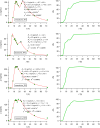The Finite Absorption Time Concept Guiding Model Informed Drug & Generics Development in Clinical Pharmacology
- PMID: 40473892
- PMCID: PMC12222261
- DOI: 10.1007/s11095-025-03878-4
The Finite Absorption Time Concept Guiding Model Informed Drug & Generics Development in Clinical Pharmacology
Abstract
Purpose: To show the implications of the incorporation of the Finite Absorption Time (F.A.T.) concept in drug development plans and in generics development and assessment and to examine regulatory implications.
Methods: Reexamining and reanalyzing published pharmacokinetic data using the pertinent models that are based on F.A.T.
Results: Comparing absorption metrics, old and new ones, shows distinct advantages and better accuracy for those based on the F.A.T.
Conclusion: The proposed approaches can be applied successfully in all phases of drug/generics development and guide changes in their strategy and in the relevant regulatory framework.
Keywords: Bioequivalence; Finite absorption time; IVIVC; Oral drugs; Pharmacokinetics; Physiologically based finite time pharmacokinetic models.
© 2025. The Author(s).
Conflict of interest statement
Declarations. Conflicts of Interest: The authors declare no conflicts of interest.
Figures










Similar articles
-
Advances in Physiologically Based Pharmacokinetic (PBPK) Modeling and its Regulatory Utility to Support Oral Drug Product Development and Harmonization.Pharm Res. 2025 May;42(5):819-833. doi: 10.1007/s11095-025-03849-9. Epub 2025 Mar 28. Pharm Res. 2025. PMID: 40155500 Free PMC article.
-
Considerations for Regulatory Reusability of Dynamic Tools in the New Drug Development.Pharm Res. 2025 May;42(5):765-771. doi: 10.1007/s11095-025-03831-5. Epub 2025 Mar 4. Pharm Res. 2025. PMID: 40038161 Free PMC article.
-
Comparative analysis of safety and efficacy between brand and generic lamotrigine products in the Saudi market.BMC Pharmacol Toxicol. 2025 Jul 1;26(1):125. doi: 10.1186/s40360-025-00963-7. BMC Pharmacol Toxicol. 2025. PMID: 40597330 Free PMC article.
-
Cost-effectiveness of using prognostic information to select women with breast cancer for adjuvant systemic therapy.Health Technol Assess. 2006 Sep;10(34):iii-iv, ix-xi, 1-204. doi: 10.3310/hta10340. Health Technol Assess. 2006. PMID: 16959170
-
A rapid and systematic review of the clinical effectiveness and cost-effectiveness of topotecan for ovarian cancer.Health Technol Assess. 2001;5(28):1-110. doi: 10.3310/hta5280. Health Technol Assess. 2001. PMID: 11701100
References
-
- Marrer E, Baty F, Kehren J, Chibout SD, Brutsche M. Past, present and future of gene expression-tailored therapy for lung cancer. Per Med. 2006;3:165–75. 10.2217/17410541.3.2.165. - PubMed
-
- Hong KW, Bermseok O. Overview of personalized medicine in the disease genomic era. BMB Rep. 2010;43:643–8. 10.5483/BMBRep.2010.43.10.643. - PubMed
-
- Vitti TG, Banes D, Byers TE. Bioavailability of Digoxin. N Engl J Med. 1971;285:1433. 10.1056/nejm197112162852512. - PubMed
-
- FDA. On January 7, 1977, FDA issued final regulations in part 320 (21 CFR 320) establishing definitions and requirements for BA and BE studies (42 FR 1624).
Publication types
MeSH terms
Substances
LinkOut - more resources
Full Text Sources

